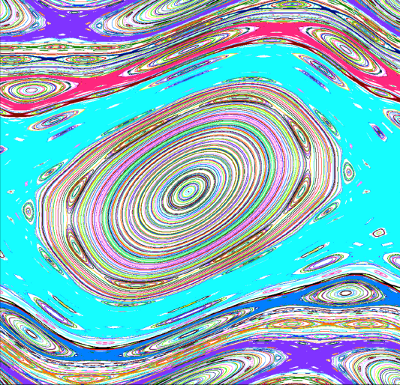
Symplectic Dynamics
 During the 2011-2012 academic year, the School of Mathematics held a special program on Symplectic Dynamics led by Helmut Hofer and John Mather.
During the 2011-2012 academic year, the School of Mathematics held a special program on Symplectic Dynamics led by Helmut Hofer and John Mather.
Symplectic Dynamics is an anticipated new field focusing on Hamiltonian systems using highly integrated ideas from the theory of dynamical systems and symplectic geometry. In recent years a number of applications of symplectic geometry to Hamiltonian dynamics supported the existence of such a field. The idea of the topical program was to bring the leading researchers from both fields together and to explore this possibility. One of the noteworthy outcomes is a breakthrough by Barney Bramham, giving a partial answer to a long-standing question by A. Katok. In particular, Katok asked the fundamental question, if area-preserving disk maps with vanishing topological entropy can be approximated by integrable systems. Bramham answers this question in the affirmative for the class of pseudorotations, which in particular contain many ergodic examples with vanishing entropy. This breakthrough is based on pseudoholomorphic curve theory, which is a central theme in symplectic geometry. His ideas also can show that certain classes of area-preserving disk maps, which are known to be weakly mixing, can never be strongly mixing.
Whereas these results are based on a deep interaction between symplectic geometry and finite-dimensional Hamiltonian systems, which was the focus of the fall term, the second term shifted to infinite-dimensional systems and partial differential equations. For example Marcel Guardia and Vadim Kaloshin were able to improve recent work on the long-term behavior of nonlinear Schrödinger operators by using ideas from Hamiltonian Dynamics concerned with problems occurring in Arnold Diffusion. During the topical year it also became clear that recent symplectic ideas might help in the study of Arnold Diffusion, so that one might expect to see in the future an influx of recent symplectic ideas to evolution equations with Hamiltonian structures as well.
The program had about 30 participants. Leading researchers, covering topics like Arnold Diffusion, Euler equations of incompressible fluids, KAM-theory, Floer-theory, Gromov-Witten theory, symplectic homology, and symplectic field theory participated.
Several mini-courses were given. John Mather talked on Aubry-Mather theory and Arnold Diffusion and Vadim Kaloshin gave a mini-course on his viewpoint of Arnold Diffusion. Sasha Shnirelman surveyed the mathematical landscape around the Euler equations. Kai Cieliebak gave a mini-course on Stein Structures based on his up-coming joint book with Yasha Eliashberg. Dusa McDuff and Katrin Wehrheim gave a series of lectures on Kuranishi Structures. Peter Albers and Katrin Wehrheim delivered an introduction to polyfolds, and Helmut Hofer gave a mini-course on the more advanced aspects of polyfold theory.
Besides the mini-courses, every week there were between two-to-three talks related to the main theme of the topical year. These talks were of very high standard and the speakers gave their talks in such a way that they were accessible for members in the rather broad audience.
During the academic year two workshops were organized. A first workshop in October 2011 was mostly devoted to finite-dimensional Hamiltonian systems. Two of the highlights were Bramham’s presentation of the before-mentioned resolution of a problem of A. Katok, and McDuff’s presentation on her resolution of the symplectic embedding problem for ellipsoids in dimension four proving a conjecture by H. Hofer.
A second workshop in symplectic dynamics in March 2012 was devoted to bringing together researchers from fluid dynamics and more generally from Hamiltonian partial differential equations, like certain nonlinear Schrödinger evolution equations, and symplectic geometers. Particularly stimulating was the presentation by James Colliander on his joint work on nonlinear Schrödinger operators and the related presentation by Marcel Guardia, explaining some Hamiltonian systems ideas in his joint work with Vadim Kaloshin, which sharpens the before-mentioned results.
In summary the topical program Symplectic Dynamics made it clear that there is a new field with integrated ideas from the theory of (finite- and infinite-dimensional) dynamical systems and symplectic geometry. Given the promising start, one should expect the new interaction to lead to solutions of long-standing problems and the study of new phenomena.
The picture was generated with a software by J. D. Meiss.